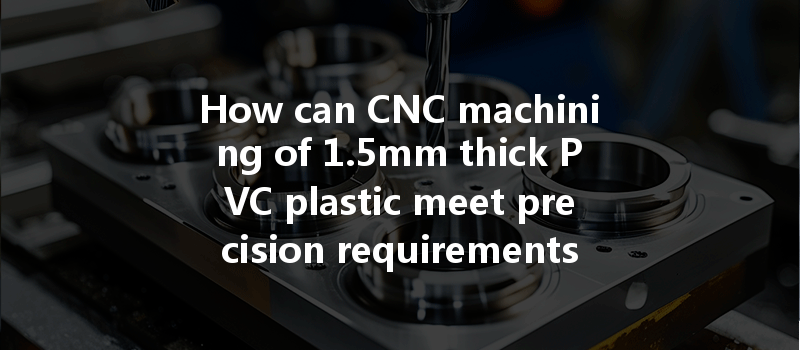Did you know that the global CNC machining market is projected to reach a value of $117.25 billion by 2027, growing at an impressive CAGR of 6.4%? This astounding statistic underscores the continual advancement of CNC (Computer Numerical Control) technology and its pivotal role in modern manufacturing. As industries increasingly rely on precise and efficient machining processes, understanding how to achieve high levels of accuracy becomes crucial—especially in the machining of thin materials like 1.5mm thick PVC plastic.
In this blog, we will dive deep into the unique challenges presented by CNC machining PVC plastic, specifically at thicknesses of 1.5mm. We will explore various techniques, tool selections, programming strategies, and machining environments that help ensure precision and efficiency. By the end of this guide, you will have a comprehensive understanding of how to get the most out of your CNC machining processes when working with this versatile yet delicate material.
Understanding PVC Plastic and Its Machinability
Characteristics of PVC Plastic
PVC, or polyvinyl chloride, is one of the most widely used plastics in the world. It is known for its durability, chemical resistance, lightweight properties, and affordability. However, machining PVC presents specific challenges due to its relatively low melting point (around 75-105 °C) and tendency to become soft when heated. When improperly machined, PVC can warp, melt, or produce rough edges, which negatively impacts precision.
Machinability Factors
When machining PVC plastic, various factors influence the machinability and precision, including:
Why Precision Matters
Achieving high precision when machining 1.5mm thick PVC is critical for several reasons:
Detailed Solutions for Achieving Precision
The foundation of achieving precision in CNC machining begins with the right tool selection. For 1.5mm thick PVC, consider the following tools:
a. End Mills
End mills designed for plastic are typically made with specific geometries that help achieve clean cuts and reduce the risk of melting. High-speed steel (HSS) and carbide end mills with a high helix angle (up to 40 degrees) work particularly well.
b. Router Bits
If you’re using a CNC router, opt for specialized plastic router bits. These bits reduce fracturing and can create detailed cuts with minimal fraying.
c. Drill Bits
When drilling into PVC, ensure that you use drill bits designed for plastics, featuring sharp cutting edges and a negative rake angle to avoid overloading the material and causing melting.
The precision of CNC machining is highly dependent on the calibration of the CNC machine itself. Regularly checking alignment, backlash, and tooling can enhance machining precision dramatically.
a. Machine Calibration Steps
Regulating cutting parameters is essential when machining 1.5mm thick PVC:

a. Cutting Speed
Recommended cutting speeds for PVC ranges from 10,000 to 15,000 RPM. However, it’s essential to monitor the cutting speed and adjust based on tool wear and heat generation.
b. Feed Rate
An optimal feed rate is generally between 200 mm/min to 600 mm/min. Lower feed rates may yield better precision but can increase the chance of overheating. It’s important to balance feed rate with cutting speed for optimal results.
c. Depth of Cut
Given the thinness of 1.5mm, a shallow depth of cut (1mm or less) is advisable. This strategy minimizes the risk of bending or breaking the material.
Maintaining the proper temperature is crucial when machining PVC. To avoid melting and ensure the longevity of both the material and tools:
a. Using Coolants
Using a liquid coolant can help manage temperatures during cutting. Consider using water-based coolants that are non-reactive with PVC.
b. Air Cooling
Alternatively, employing air cooling techniques using compressed air to blow away chips and dissipate heat can also contribute to maintaining cooler tool and material temperatures.
Using the right machining strategies helps in ensuring precision:
a. Clamping
Securely clamping the PVC workpiece is critical for avoiding movement during machining. Utilize custom fixtures or vacuum clamps for thin materials to minimize warping.
b. Tool Path Optimization
Optimize tool paths by minimizing unnecessary movement. Use techniques such as contouring and pocketing to ensure efficient material removal while preserving accuracy.
c. Multiple Passes
Instead of trying to achieve the entire depth in one pass, use multiple light passes to maintain control over heat and pressure, significantly improving the finish and precision.
Once machining is complete, surface finishing plays a crucial role in achieving the desired quality:
a. Deburring
Use a deburring tool or sandpaper to remove any sharp edges left from the machining process. This operation is particularly vital with plastic, as sharp edges can pose safety risks.
b. Polishing
Engage in light polishing to enhance the aesthetic quality of the PVC part while simultaneously providing a smoother finish. This process also reduces friction and wear when the part is in use.
c. Inspection
Finally, conduct thorough inspections using calipers and gauges. Verification ensures that tolerances are within specified limits and that dimensions meet required standards.
In this extensive guide, we’ve explored how to achieve precision in CNC machining of 1.5mm thick PVC plastic. Understanding the unique characteristics of PVC, making informed choices around tool selection, optimizing machine calibration, configuring appropriate cutting parameters, employing effective cooling techniques, and utilizing smart machining strategies are all imperative in this process.
Precision in CNC machining of PVC is not merely an operational goal; it’s a necessary aspect for producing high-quality parts that meet industry standards. With manufacturing moving toward greater efficiency and accuracy, honing your skills in CNC processing of plastics is worthwhile.
Ultimately, as the CNC machining market continues to grow, those who grasp the fundamentals of machining materials like PVC will position themselves to thrive within the industry. The insights and strategies presented in this blog are critical to navigating the challenges of CNC machining and adopting practices that foster innovation and excellence in manufacturing.
Thank you for reading this detailed exploration on precision machining with PVC. We encourage you to apply these techniques in your projects and rethink your machining strategies for better efficiency and quality.






